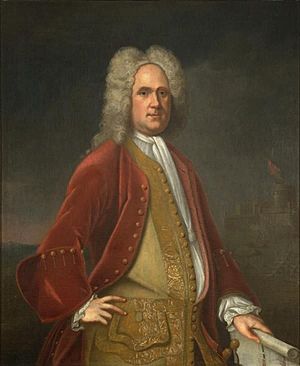Charles Bridges (painter) facts for kids
Quick facts for kids
Charles Bridges
|
|
|---|---|
| Died | 1747 |
| Nationality | English |
| Other names | England |
| Occupation | Painter, missionary |
|
Notable work
|
Portrait of Alexander Spotswood (1736) Portrait of James Blair (c. 1735–43) |
| Spouse(s) | Alice Flower (m. 1687) |
Charles Bridges (born 1672 – died 1747) was an English painter and missionary. He worked in Virginia from 1735 to 1744. He is known as the first painter whose work in Virginia is officially recorded.
Life as a Painter and Missionary

Charles Bridges was born in Barton Seagrave, England. His family was well-known and educated. His brother, John Bridges, was a lawyer and historian. Charles married Alice Flower in 1687. They had at least three children.
Bridges worked for an organization called the Society for Promoting Christian Knowledge. He helped with charity schools in London. It's not clear when he became a painter. We only know of one painting he made before moving to Virginia. It was a portrait of Thomas Baker, painted after 1717.
In 1735, Bridges moved to Williamsburg, Virginia, with his children. He had letters of introduction to important people. These included James Blair and Lieutenant Governor William Gooch.
He soon met William Byrd II, a wealthy landowner. Bridges lived at Byrd's home, Westover Plantation, for a while. During this time, he painted portraits of Byrd's children. Byrd described Bridges as a talented painter. He said Bridges was a "man of a good family."
Bridges also discussed starting a charity. This charity would teach Christianity to the African-American community in Virginia. However, this idea did not happen. Many landowners worried that Christianity might be linked to freedom.
Bridges remained friends with William Byrd. He visited Westover Plantation several times. One of his daughters passed away in Williamsburg in 1736. He then rented a house in town for a year. Later, he moved to Hanover County. He stayed there until about 1744, when he returned to England. Charles Bridges died in his home county of Northamptonshire. He was buried in the church of Warkton.
Some historians think Bridges' return to England might have encouraged William Dering to start painting portraits. It's possible Dering bought painting supplies from Bridges.
His Art and Style
We know for sure about only a few portraits by Charles Bridges. These include some mentioned by William Byrd. There is also a portrait of William Gooch. Another is Mrs. Mann Page II and Child, owned by the College of William and Mary.
Bridges did not sign his paintings. This makes it hard to know for sure which ones he painted. Also, many of his old paintings are not in perfect condition. This makes it even harder to identify them.
However, we can often recognize Bridges' style. He used wide brushstrokes for faces, hair, and clothing. He drew features, especially eyes, very carefully. His colors were usually soft and not too bright. He often used red to show shadows.
Many of his portraits have a similar look. The people's heads and bodies are turned slightly to one side. They look directly at the viewer.
Besides the paintings mentioned, other works are thought to be by Bridges. These include portraits of William Prentis and James Blair. You can find paintings attributed to Bridges in several collections. These include Washington and Lee University and the Colonial Williamsburg Foundation.
Bridges also did other types of art. In 1740, he was paid for "drawing the King's Arms." This was for the court in Caroline County. The portrait of James Blair is special. It shows one of the earliest pictures of the Wren Building in its background.


